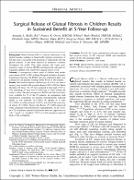| dc.contributor.author | Amanda L., Reilly | |
| dc.contributor.author | Francis R., Owori | |
| dc.contributor.author | Ruth, Obaikol | |
| dc.contributor.author | Elizabeth, Asige | |
| dc.contributor.author | Harriet, Aluka | |
| dc.contributor.author | Norgrove, Penny | |
| dc.contributor.author | Robert, Olupot | |
| dc.contributor.author | Coleen S., Sabatini | |
| dc.date.accessioned | 2023-09-12T12:23:48Z | |
| dc.date.available | 2023-09-12T12:23:48Z | |
| dc.date.issued | 2021 | |
| dc.identifier.citation | Amanda, R. L., Owori, F. R., Obaikol, R., Asige, E., Aluka, H., Penny, N., & Sabatini, C. S. (2021). Surgical Release of Gluteal Fibrosis in Children Results in Sustained Benefit at 5-Year Follow-up. | en_US |
| dc.identifier.uri | https://ir.sun.ac.ug//handle/123456789/88 | |
| dc.description | Original Article | en_US |
| dc.description.abstract | Background: Gluteal fibrosis (GF) is a fibrotic infiltration of the
gluteal muscles resulting in functionally limiting contracture of
the hips and is associated with injections of medications into the
gluteal muscles. It has been reported in numerous countries
throughout the world. This study assesses the 5-year postoperative
range of motion (ROM) and functional outcomes for
Ugandan children who underwent surgical release of GF.
Methods: A retrospective cohort study of children who underwent
release of GF in 2013 at Kumi Hospital in Eastern Uganda.
Functional outcomes, hip ROM, and scar satisfaction data were
collected for all patients residing within 40 km of the hospital.
Results: One hundred eighteen children ages 4 to 16 at the time of
surgery were treated with surgical release of GF in 2013 at Kumi
Hospital. Of those 118, 89 were included in this study (79.5%).
The remaining 29 were lost to follow-up or lived outside the
study’s radius. Detailed preoperative ROM and functional data
were available for 53 of the 89 patients. In comparison with
preoperative assessment, all patients postoperatively reported
ability to run normally (P<0.001), sit upright in a chair
(P< 0.001), sit while eating (P<0.001), and attend the entire day
of school (P< 0.001). Passive hip flexion (P<0.001) improved
when compared with preoperative measurements. In all, 85.2%
(n= 75) of patients reported satisfaction with scar appearance as
“ok,” “good,” or “excellent” 29.2% (n= 26) of patients reported
back or hip complaints.
Conclusions: Overall, the 5-year postoperative outcomes suggest
that surgical release of GF improves ROM and functional
quality of life with sustained effect.
Level of Evidence: Level IV—case series.
Key Words: gluteal fibrosis, injection injury, pediatric hip contracture,
fibrosis surgery, treatment outcome, Uganda | en_US |
| dc.language.iso | en | en_US |
| dc.publisher | Wolters Kluwer Health, Inc | en_US |
| dc.subject | Key Words: gluteal fibrosis, injection injury, pediatric hip contracture, fibrosis surgery, treatment outcome, Uganda | en_US |
| dc.title | Surgical Release of Gluteal Fibrosis in Children Results in Sustained Benefit at 5-Year Follow-up | en_US |
| dc.type | Article | en_US |

